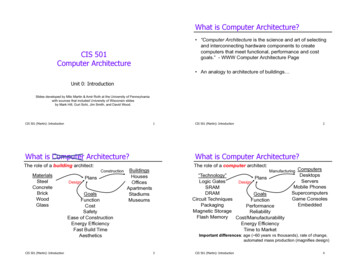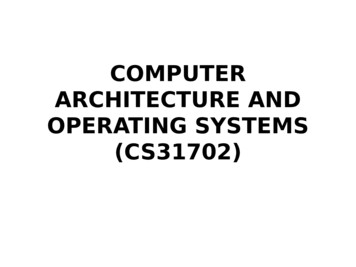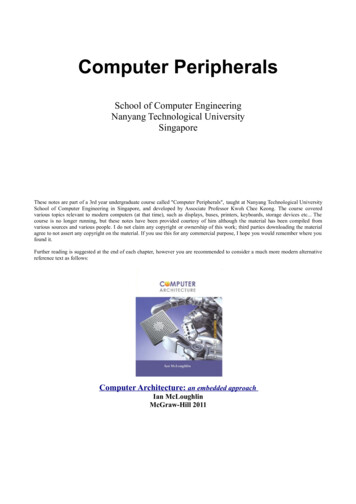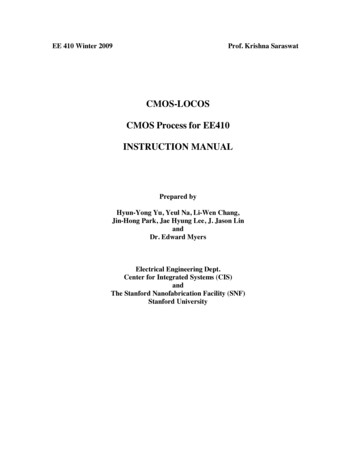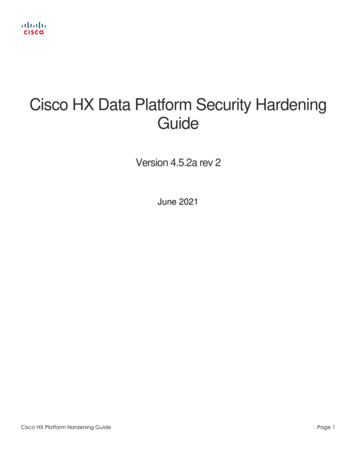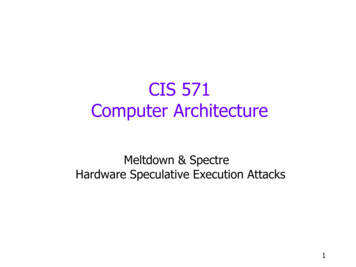
Transcription
CIS 571Computer ArchitectureMeltdown & SpectreHardware Speculative Execution Attacks1
Who discovered these bugs?These bugs were discovered in 2017, and publicized in January 20182
Side and Covert Channels3
Side Channels and Covert Channels A side channel is a mechanism that leads to inadvertentinformation transfer e.g., going through your neighbor’s recycling A covert channel is a mechanism used for illicitcommunication between two cooperating parties e.g., a double-agent spy communicating with their handler Both channels result in undesired information transfer Computer programs can have such channels even programs that utilize secrets, like encryption keys We focus especially on side channels, as they’re more dangerous4
Example side channelboolean secret true;int array[1024] { };if (secret) {array[0] ;} else {array[500] ;} Threat Model: what the attacker can do can’t change the hardware or OS, which work correctly can run arbitrary programs at arbitrary times How can we learn the secret? go through the program’s recycling and see what we find5
Example side channelboolean secret true;int array[1024] { };if (secret) {array[0] ;} else {array[500] ;}AB We fill up the cache with known data Then, run the secret program Then, see what’s left in the cache access all the known data, see whichaccesses are fast and which are slow Caches can be a side channel inadvertently revealing informationabout program executionCDarray[0]ABBCarray[500]DD6
Cache Side Channel Attacks Can be used for both: side channel (unintentional communication) covert channel (intentional communication) We can steal SSH private keys this way20057
Side channels are delicate Might have to go through a lot of recycling to find whatyou’re looking for side channels often require many executions to recover a secret Other side channels: power consumptionexecution timeelectromagnetic radiationmicroarchitectural features like contention for execution portsattackers always find new ones8
Abusing OoO Execution9
Meltdown codeLet’s read kernel memory from userspace :-)r0, r1: tempsr2: kernel address we wish to readr3: start of probe arrayldrslladdldrr0r0r1r1 -[r2]r0, #6r3, r0[r1]What does this code do?Based on the data value at [r2],we access a particular cache lineof probe array.10
Meltdown code on an OoO processorLet’s read kernel memory from userspace :-)r0, r1: tempsr2: kernel address we wish to readr3: start of probe arrayldrslladdldrr0r0r1r1 -[r2] this raises an exception but not until Commit!r0, #6After the exn, we clear ther3, r0ROB and other OoO structures[r1]but not the caches, leavingopen a side channel!11
Speculative Execution Attacks An OoO processor speculates aggressively on a mis-speculation, the incorrect instructions are wiped away andhave no ISA-level visible impact register writes, memory stores are all cleaned up non-ISA level changes like cache contents are not cleaned up insns that roll back can still leak information via a side channel! These attacks strike at core principles of OoO execution undiscovered since 1990s?12
Meltdown experiment Real Meltdown uses pages instead of cache lines,exploiting a TLB side channel13
Meltdown Mitigations Meltdown affects Intel OoO and some ARM OoOprocessors, AMD is immune Intel did page permission checks at Commit, not Execute Intel cores have hardware fixes as of 2019 Meltdown can be patched in software all major OSes released patches in 2018 performance impact for system calls KPTI/KAISER Linux patch maps minimal kernel code/data14
Spectre Attacks15
What happens on a Context Switch Operating system responsible to handle context switching Hardware support is just a timer interrupt Each process has an associated data structure which is usedto record relevant state such as: Architected state: PC, registers, Page table pointer Save and restore them on context switches Memory state? Non-architected state: caches, predictor tables, etc. Ignore or flush ignoring is key aspect of Spectre/Meltdown vulnerabilities! OS swaps out values for old process, swaps in values fornew process and restarts the system.CIS 571: Comp. Org. Dr. Joe Devietti Virtual Memory16
Spectre Attack Goal: trick another process into leaking information Let’s say my secure program contains this code:if (x array1 size) {y array2[array1[x] * 256];} If attacker controls x, value of array1[x] can be leaked problem: how to get around the bounds check?17
Poison the branch predictor How do I poison the BHT/BTB? If I know the BHT/BTB entries that will be used for the boundscheck branch, I can train them in advance e.g., branch with the same PC in the attacker process Not hard when the attacker provides their own code JavaScript, VM on EC2 How do I get the victim to run the vulnerable code? highly victim-specific easiest in JIT environments Spectre paper shows how to read Chrome-internal state fromJavaScript18
Spectre Mitigations Spectre affects OoO chips from everyone confirmed on Intel, ARM, AMD Software patches are incomplete, slow Reduce use of indirect branches Disable speculation through special instructions at “critical” codepoints Ultimately, Spectre attacks aren’t that easy to pull off19
e.g.,a double-agent spy communicating with their handler . even programs that utilize secrets, like encryption keys Wefocus especially on side channels, as they’re more dangerous 4. Example side channel Threat Model: what the attacker can do can’t change the hardware or OS, which work



